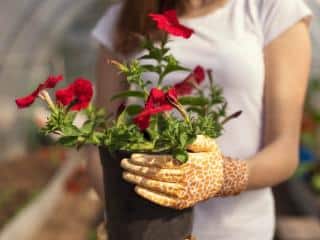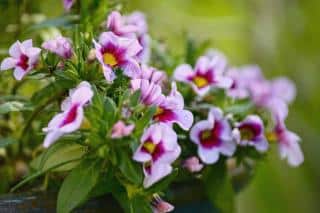

Calibrachoa is a very beautiful flower that bears hundreds of small bell-shaped flowers
Key Calibrachoa facts
Name – Calibrachoa
Family – Solanaceae or nightshade
Type – annual
Height – 6 to 20 inches (50 cm)
Exposure – sun or part sun
Soil: rather rich, not too chalky – Flowering: end spring → fall
Calibrachoa is often used as a cascading flower for suspended pots and overhangs. Even though it is a perennial in warmer areas, in temperate climates it is grown as an annual but its blooming lasts a long time.
 It is recommended to plant this petunia-related plant in spring, after any risk of freezing is over, because it doesn’t survive freezing well.
It is recommended to plant this petunia-related plant in spring, after any risk of freezing is over, because it doesn’t survive freezing well.
For seeds, start sowing in a tray indoors, in your home, starting in February/March.
Simply press the seeds down to ensure they stick to the special “seedling soil mix”, without covering them over.
Water regularly to retain moisture, but not too much.
When the first leaves of your calibrachoa pop out, transplant to nursery pots and wait for the last frost to have passed before planting them outdoors.
Whether the plant is in a container or in the ground, select a sun-filled spot for maximum blooming.
 To enhance flower-bearing, you can remove wilted flowers regularly.
To enhance flower-bearing, you can remove wilted flowers regularly.
During spells of high temperatures, feel free to water in the evening to avoid having your calibrachoa dry out.
Remember that hanging calibrachoa will need water more often than those in pots near the ground.
Calibrachoa are native to provinces in Southern Brazil and Northern Uruguay.
Related genetically to the petunia, the only way to tell them apart is in a laboratory by looking at their chromosome count.
This is a semi-hardy annual. It bestows us with a very beautiful blooming from the beginning of spring until fall.
It loves sun and well-drained fertile ground.
Calibrachoa can be found in flower beds, along edges and in rocky ground. It produces very beautiful spots of color.
Many hanging pots also harbor calibrachoa.
This flower is perfectly suited to growing in suspended pots because its leaves and flowers dangle and tumble along the side like a waterfall.
Flower your garden, balcony or terrace with calibrachoa for a landscape that is full of colors!